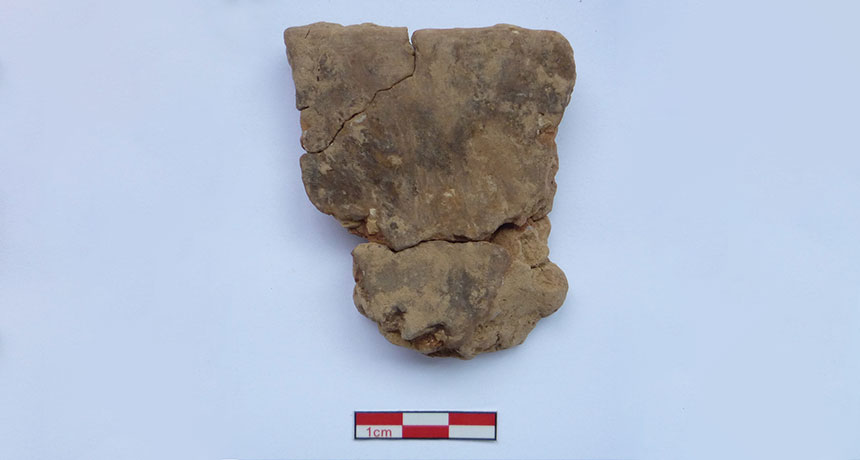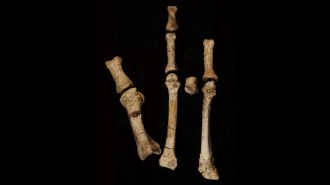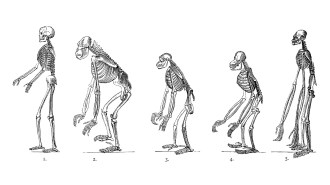Pots from hunter-gatherer site in China tell tale of lifestyle shift
Find pre-dates agriculture, suggesting farmers weren’t the first to adopt more settled living habits

CERAMIC INNOVATORS Newly discovered remains of pottery made by hunter-gatherers living on China’s central plain around 10,000 years ago include plain pieces (shown) and decorated pieces.
Y. Wang et al/Antiquity 2015
East Asia’s first farmers didn’t transform ancient foraging cultures as much as researchers have traditionally thought. That’s because roving groups of foragers adopted sedentary living habits first.
New evidence suggests that hunter-gatherers living on China’s central plain made pottery and formed permanent settlements between 10,500 and 10,000 years ago, hundreds of years before a farming lifestyle with those features emerged there. Foragers at that time inhabited a resource-rich area that enabled them to settle down and make ceramics, propose Youping Wang of Peking University in Beijing and his colleagues in the April Antiquity. Agriculture soon followed, with the rise of millet farming in North China and rice farming in South China occurring within 500 to 1,000 years.
A previously unknown ceramic style found at Lijiagou, a site discovered during a 2004 archaeological survey, indicates that East Asian pottery making preceded farming there. Wang’s team conducted excavations in 2009 and 2010. Amid numerous small, sharp-edged stone implements unearthed in a soil layer that predates farming in the area, the researchers found two undecorated pottery fragments.
Sediment just above those finds yielded more than 200 ceramic pieces with line designs and additional stone artifacts, also made by hunter-gatherers. Two related hunter-gatherer groups occupied the site for several hundred years, starting around 10,500 years ago, the researchers conclude.
Radiocarbon dating of charcoal bits from both soil layers provided ages for the pottery.
Bones of hunted animals at the site, including wild cattle and several deer species, suggest that Lijiagou hunter-gatherers lived in an area dotted with marshes, forests and open grasslands. Many cattle bones were broken into pieces, raising the possibility that they were boiled to extract grease or marrow. The hunter-gatherers may have used ceramic pots to boil the bones.
Pottery linked to farmers of the Jiahu culture, known from a nearby site on China’s central plain, had previously been unearthed from younger layers of Lijiagou sediment. Jiahu culture emerged between 9,500 and 9,000 years ago, and lasted until 8,600 years ago.
Discoveries at Lijiagou “for the first time produce a bridge between East Asian hunter-gatherers who retreated to favorable habitats starting around 12,000 years ago and early Jiahu farming communities,” says archaeologist David Cohen of National Taiwan University in Taipei.
It’s not known if pottery-making Lijiagou hunter-gatherers transitioned directly into Jiahu farmers. Based on pottery differences between those groups, Wang’s team suspects that Jiahu farmers moved to China’s central plain from elsewhere and had no ties to local foragers.
Whatever transpired, it’s becoming increasingly apparent that “hunter-gatherer lifestyle changes, as indicated by the early appearance of ceramics at Lijiagou, preceded shifts to agriculture,” says archaeologist Robert Bettinger of the University of California, Davis.
A Southeast China cave has yielded the oldest known pottery, from about 20,000 years ago — at least 10,000 years before farming began in that part of the world (SN: 7/28/12, p. 15). Until the discoveries at Lijiagou, though, it was unclear whether nonagricultural and agricultural pottery makers in East Asia had lived in any one region at close to the same time.
Bettinger, who did not participate in the new study, has worked at an ancient farming site in North China called Dadiwan. Excavations there suggest that hunter-gatherers developed part-time millet farming between 7,900 and 7,200 years ago. At that time, Dadiwan hunter-gatherers moving among seasonal camps sought quick-growing, storable crops for themselves and their hunting dogs. “The shift to agriculture occurred in several places, not always following the same pattern,” Bettinger says.







